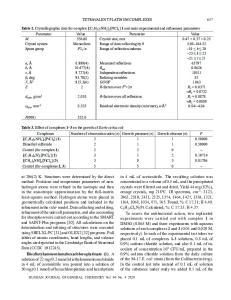Chiral Steroidal Phosphines: Synthesis and Platinum Complexes
The synthesis of novel 3− and 17-diphenylphosphino-androstane derivatives via homogeneous catalytic P-C coupling is described. The products were characterized by 1H and 31P NMR measurements. According to the NMR investigation of the PtCl2P2-type complexes
- PDF / 19,184,411 Bytes
- 165 Pages / 612.24 x 793.68 pts Page_size
- 40 Downloads / 359 Views
SpringerWienNewYork
Prof. Dr. Karl Kirchner Institute ofInorganic Chemistry, Vienna University of Technology, Vienna, Austria
Prof. Dr. Walter Weissensteiner Institute of Organic Chemistry, University of Vienna, Vienna, Austria
This work is subject to copyright. All rights are reserved, whether the whole or part of the material is concerned, specifically those of translation, reprinting, re-use of illustrations, broadcasting, reproduction by photocopying machines or similar means, and storage in data banks. © 2001 Springer-Verlag Wien
Typesetting: Thomson Press (India) Ltd., New Delhi
Printed on acid-free and chlorine-free bleached paper With 28 Figures CIP data applied for
Special Edition of Monatsheftefor ChemielChemical Monthly Vol. 131, No. 12,2000
ISBN 3-211-83599-7 Springer-Verlag Wi en New York
Editorial The field of organometallic chemistry has rapidly increased in importance over the past decades since the landmark discoveries in the 1950's of e.g. ferrocene, Wilkinson's catalyst, Ziegler's catalyst, and the Wacker process. Meanwhile, organometallic compounds, particularly of the transition metals, have found many applications in homogeneous catalysis and in the development of new synthetic methods and materials. This issue of Chemical Monthly is dedicated to recent work on organometallic complexes of the late transition metals, including mechanistic and synthetic studies, ligand design, and new applications in homogenous catalysis. At first two review papers are presented. The article of Nagashima describes the activation of dihydrogen by a tricarbonylruthenium cluster containing acenaphthalene and azulene ligands. The role of these hemilabile JL3-ligands is discussed, and new insight into cluster analysis is presented. Clearly, cluster compounds are an important topic of modem organometallic chemistry. The review article by Kirchner, Schmid, and coworkers deals with the recent chemistry of the trisacetonitrile complex [RuCp(CH 3CN)3]+, focusing on its synthetic potential as well as on mechanistic aspects and future applications in homogeneous catalysis. The next part of this issue includes research papers on synthetic, mechanistic, and theoretical aspects of late transition organometallics. New developments in the synthesis and structure of copper(l) complexes containing the 1,1' -bis-(diphenylphosphino)-ferrocene ligand are reported by the group of Calhorda. In the contribution by the lalon group, binuclear palladium complexes with a half-Aframe structure and their fluxional behaviour in solution are described. The group of Trzeciak and Ziolkowski is treating mechanistic aspects of reactions related to benzyl bromide carbonylation mediated by palladium complexes. New mechanistic insight into the nickel-catalyzed electro synthesis of ketones by the heterocoupling of acyl and benzyl halides can be gained from the contribution of the group of Amatore and lutand. The group of Aviles reports on a self-assembly process of Ag+ with trans-azobenzene to afford a novel coordination polymer with a 2D sup
Data Loading...











